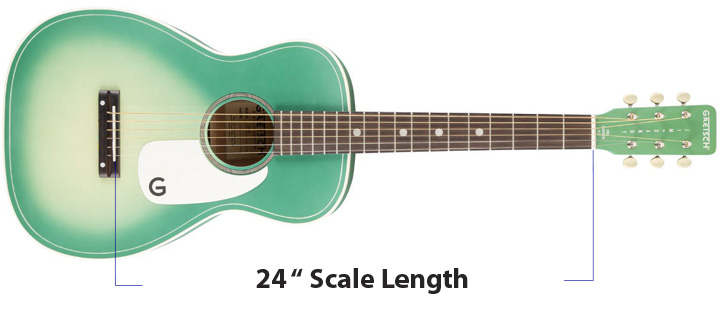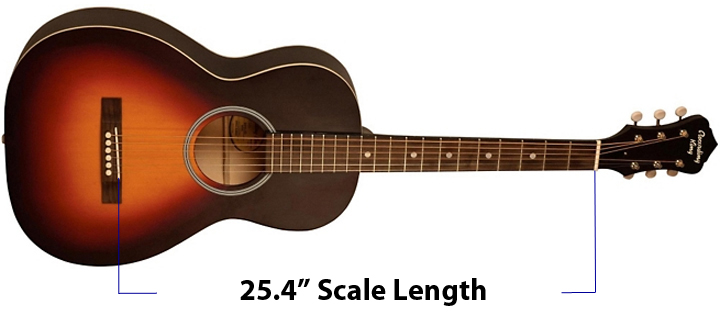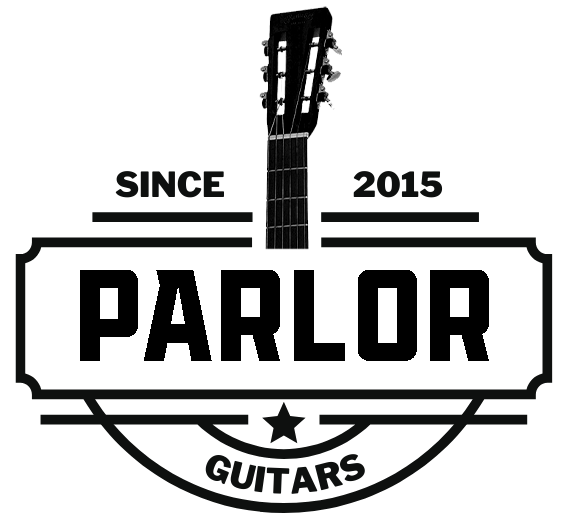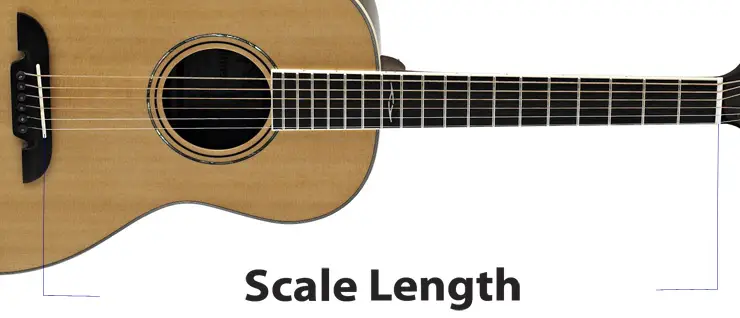Do you consider “scale length” when buying guitars, or are you too busy worrying about guitar brands, tonewood and finish? Knowing more about this often neglected but equally important specification, will help you find guitars that you will truly enjoy playing. Here we look at the relevance of scale length when it comes to parlor guitars.
Do you consider “scale length” when buying guitars, or are you too busy worrying about guitar brands, tonewood and finish? Knowing more about this often neglected but equally important specification, will help you find guitars that you will truly enjoy playing. Here we look at the relevance of scale length when it comes to parlor guitars.
What is Scale Length?
Nowadays, scale length is rarely even mentioned at guitars stores, and if it were, it usually is only mentioned in passing. This results in acquiring instruments that may end up being frustrating to play. To avoid this, we should have a good grasp of what guitar scale length is all about – Scale Length is the length of the stretched string from the nut to the bridge saddle, this length determines the string tension and fret spacing.
When the scale length is longer, string tension is higher because of the increased stretching of the strings to cover the longer distance. Conversely, shorter scale length allows for more relaxed strings while still retaining the same concert pitch tuning, because of the shorter distance from the nut to the saddle. Fret spacing is directly proportional to scale length, the longer the length, the wider the space between frets. Short scale length guitars will have narrower frets which become even narrower at the upper frets.
Scale length is the reason why (all things being equal) small string instruments like parlor guitars are easier to play than regular sized ones – the shorter scale length allows for strings to be relaxed and easier to fret. However, reduced string tension results in lack of sustain and loss of some of the high and low frequencies, which gives short scale guitars a warmer mid-range focused sound.
Advantages and Disadvantages
Since the common scale length of standard sized guitars is 25.4″, you can consider anything lower than that to be small scale. But since we’re dealing with parlor guitars, we will lower the limit to less than 25″ to better separate the long and short scale parlor acoustics.

Short scale parlor guitars (less than 25″) follow traditional designs and as such they reproduce the vibe and feel of old parlor guitars quite nicely. Having less tension on the strings makes them easier to play, which in turn allows for longer practice and jams. Although this playability may not be obvious at first try, you will find that you don’t tire as easily when playing these parlor guitars, you can think of it as lifting lighter weights that allow for more repetitions. This relaxed feel is ideal for guitarists that have hand problems. Combine this playability with the parlor guitar’s compact body and you’ve got the perfect pickup instrument that you can place anywhere. While the vintage style midrangey tone may not be as versatile, it will be appreciated by experienced players – especially those that play blues, jazz and folk. If you are looking for a true to form blues box, or you are looking for a comfortable guitar that you can play for longer periods, then short scale guitars are for you.
Short scale guitars also have a lot of advantages for children learning to play – for details see: A Parlor is the Best Acoustic Guitar for Kids – Here’s Why….

Long scale parlor guitars (25″ and up) provide the vintage appeal of old parlor designs while utilizing a more familiar neck feel. This makes them great transition instruments for multi-instrumentalists that want to enjoy the benefits of small guitars while retaining the feel and playability of bigger guitars. They are the logical choice if you want a parlor guitar that is consistent with your other instruments. If it also matches the neck profile and nut width, you won’t have to adjust your playing technique every time you pickup your parlor acoustic, and as such it becomes a powerful practice tool. These parlor guitars also sound closer to regular sized acoustics, with clear and balanced tone that works well with various musical styles. If you are looking for consistency across multiple instruments and you prefer modern clear voicing, then you should check out long scale parlor guitars.
Know your Options
Parlor guitars come in various shapes and sizes, and this includes having different scale lengths. Most parlor guitars come with a short scale length of less than 25″, and this is to be expected because of its smaller than usual size. Still there are some manufacturers that build parlor style guitars with long scale lengths. Here are some examples of production model parlor style guitars and their scale lengths:
- At just 24″ scale length, the Gretsch G9500 Jim Dandy Flat Top and Alvarez AP70 come with significantly shorter necks.
- The recently released Washburn WP26SENS and the classic Gibson 1937 L-00 Legend are examples of traditional style parlor guitars, both of which having a scale length of 24.75″. Market favorite Epiphone EL-00 Pro also have the same Gibson-esque scale length.
- The Eastman E20P, Ibanez AVN1 and Martin 0-28VS are slightly longer at 24.9″ but still within the short scale range. The Breedlove Premier Rosewood Parlor is slightly longer with a PRS-like scale length of 25.”
- Examples of long scale parlor guitars that have almost the same scale length as regular sized acoustics include the Takamine P3NY, Cort L1200P and Fender Ron Emory Loyalty, both having 25.3″ scale length.
- At 25.4″ the Loar LO-215 and Recording King RPH-05 are considered long scale parlor guitars, and they will have the same feel and fret spaces as regular sized acoustics.
Conclusion
Before starting your guitar hunt, it is best to research the scale length of the guitars that feel comfortable to you. Be it your current guitar, one that you borrowed from a friend, or a display instrument at a store that you found particularly easy to play. You can then use the list above to find the parlor guitar that is close to your preferred scale length to kick start your search. Without further ado, happy guitar hunting!


8 thoughts on “The Long and Short of Parlor Guitar Scale Lengths”
Hello, what size straight edge notched tool fits a 24 inch scale? I can’t find one that exact size.
Thanks
I am a learner of guitar and from this article I came to know about the scale length and different parameters associated with the scale length. This is an unusual topic and I am interested to know about the guitar repair and hardware components. I have also studied the Tune-O-Matic bridge of Gibson guitar and the process of setting up the string to the bridge. This also helps to boost up my knowledge of guitar components.
I am a learner of guitar and from this article I came to know about the scale length and different parameters associated with the scale length. This is an unusual topic and I am interested to know about the guitar repair and hardware components. I have also studied the Tune-O-Matic bridge of Gibson guitar and the process of setting up the string to the bridge. This also helps to boost up my knowledge of guitar components.
I am trying to repair this little classical that arrived with the bridge ripped off. I chiseled out the old glue down to the plywood .Now I need a new complete bridge for a parlor so I can figure out what I need to do to make it fit. This appears to be a short scale. The I.D. shows no model number, Made in Germany. Can you tell me where to buy a bridge?
Where are you located?
I am a learner of guitar and from this article, I came to know about the scale length and different parameters associated with the scale length. This is an unusual topic and I am interested to know about the guitar repair and hardware components. I have also studied the Tune-O-Matic bridge of Gibson guitar and the process of setting up the string to the bridge. This also helps to boost up my knowledge of guitar components.